Subscribe to our Newsletter
Get regular stories, tips and solutions from Sustainable America and opt-in to receive roundups of the latest food and fuel news.

Oct 25th, 2013 | By Aubrey Yee
Clean Energy Fuel releases Redeem, a truly renewable natural gas fuel made from landfill methane gas, to be sold at 40 filling stations across California.
Continue Reading
Sep 24th, 2013 | By Aubrey Yee
Earthships are structures made from old tires and bottles, produce all the energy they need to operate, recycle water for multiple uses and grow food on site. What could be more sustainable than that?
Continue Reading
Sep 20th, 2013 | By Aubrey Yee
A new ranking of U.S. domestic airlines based on fuel efficiency makes it easier for passengers to choose a lower carbon footprint on their next flight.
Continue Reading
Sep 13th, 2013 | By Aubrey Yee
Insects contain more protein per pound than any meat and are easy to raise with little polluting side effects. Will we all eat insects in the future?
Continue Reading
Aug 28th, 2013 | By Aubrey Yee
Farm Hack brings hi-tech innovation to the traditionally low-tech world of farming.
Continue Reading
Aug 15th, 2013 | By Aubrey Yee
One of the critical hurdles that farmers in urban areas face is access to affordable land for growing food. The concept of a multi-locational or decentralized farm is an elegant solution to growing food in diverse urban and suburban settings. It seems that more and more farms are using the multi-locational model. We found quite a few successful operations in Canada in particular.
Continue Reading
Aug 12th, 2013 | By Aubrey Yee
The quest for *commercial-scale* production of cellulosic ethanol has been under way for some time now. Despite the exciting potential of ethanol produced from renewable sources, real progress has been slow: KiOR's first shipment of cellulosic gasoline was delivered in late June, and the DuPont refinery is still being built. But just last week, INEOS Bio announced that they are officially producing cellulosic ethanol at a commercial scale.
Continue Reading
Aug 2nd, 2013 | By Aubrey Yee
For people who work late hours and have families to manage or long commutes, finding the time to shop at farmer's markets or pick up a CSA box is often not feasible. So a lot of people who otherwise would love to have easy access to local fresh food get left out of the equation. A growing number of organizations are trying to bridge this gap by bringing CSAs directly to workplaces, which is a boon to all involved: workers, employers, and local farmers.
Continue Reading
Jul 16th, 2013 | By Aubrey Yee
Whether you want to take a day trip to learn how lavender is farmed or stay a few days on a working farm to learn about organic agricultural methods, there are a multitude of agritourism experiences available right here in America.
Continue Reading
Jul 12th, 2013 | By Aubrey Yee
Last spring, the city of Seattle announced plans for the nation's first food forest, and people around the country immediately took notice. News of the 7-acre public park to be converted into a free, open, public food forest spread through blogs and other news publications and before long others decided to embrace the idea for their own community.
Continue Reading
Jul 1st, 2013 | By Aubrey Yee
This Tuesday, President Obama unveiled a new plan aimed at curbing carbon emissions and reducing America's dependance on oil.
Continue Reading
Jun 24th, 2013 | By Aubrey Yee
Despite filing bankruptcy last month, EV innovator Better Place leaves behind valuable ideas and lessons for the future of electric vehicles.
Continue Reading
Jun 17th, 2013 | By Aubrey Yee
With electric vehicles becoming an increasingly popular way to save money on gasoline and promote sustainability, more employers are installing charging stations at the workplace.
Continue Reading
May 30th, 2013 | By Aubrey Yee
Oprah is known for starting contagious trends, and some hope that her decision to grow food on 16 acres of her Maui estate will spark a trend in local food production nationwide.
Continue Reading
May 15th, 2013 | By Aubrey Yee
Ron Finley wants everyone to understand “growing your own food is like printing your own money.” The group he founded is LA Green Grounds. Their mission: "Growing, working, teaching: changing turf into edible gardens in South Los Angeles."
Continue Reading
Apr 15th, 2013 | By Aubrey Yee
China surpasses the U.S. to become the world's number-one importer of crude oil and petroleum products.
Continue Reading
Apr 9th, 2013 | By Aubrey Yee
FarmedHere turns a 90,000-square-foot abandoned Chicago warehouse into a food-producing powerhouse.
Continue Reading
Apr 5th, 2013 | By Aubrey Yee
The city of Houston has won a prize from Bloomberg Philanthropies to make their "One Bin for All" plan a reality. With the country's first total resource recovery facility in place, the city plans to find productive uses for discarded food and other recyclables.
Continue Reading
Mar 29th, 2013 | By Aubrey Yee
Gleaning is the practice of gathering food that is left behind after harvest, usually to feed those in need. Modern-day permutations of this ancient practice are bringing food to the hungry and reducing food waste in America.
Continue Reading
Mar 27th, 2013 | By Aubrey Yee
The biofuels industry's thirst for corn and soy ethanol is driving a rush to convert Midwest grasslands to croplands. But how much is too much?
Continue Reading
Mar 22nd, 2013 | By Aubrey Yee
With commercial composting starting to take off, innovative businesses are harnessing the profit potential of turning everyday organic waste into compost for sale - savings tons of food from the landfill and reducing greenhouse gas emissions.
Continue Reading
Mar 13th, 2013 | By Aubrey Yee
New all-electric motorcycles from Zero and Brammo save on gas but don't skimp on style.
Continue Reading
Mar 6th, 2013 | By Aubrey Yee
Range anxiety is still a reality for drivers of electric vehicles. A recent study from the Department of Energy suggests that a corridor of charging stations in the northeastern U.S. could help increase demand for plug-in electric vehicles in the future.
Continue Reading
Mar 4th, 2013 | By Aubrey Yee
A diverse food system is a more secure food system. With extreme weather and other pressures on our food supply, age-old practices like seed sharing are becoming more important for the future.
Continue Reading
Feb 27th, 2013 | By Aubrey Yee
Fast driving decreases your vehicle's fuel economy more than you might imagine. Find out how to separate mpg fact from fiction and how to increase your fuel economy without buying a new car.
Continue Reading
Feb 22nd, 2013 | By Aubrey Yee
EPA mandates for cellulosic biofuel blends cannot be met as production is literally non-existent. How the EPA manages the mandates for 2013 may have a direct effect on food prices at the grocery store in the near future.
Continue Reading
Feb 18th, 2013 | By Aubrey Yee
The future of farming may be urban. At the very least, the notion of Agritecture asks us to look at ways that buildings and agriculture can be integrated quite seamlessly.
Continue Reading
Feb 15th, 2013 | By Aubrey Yee
In our interconnected world, the U.S. renewable fuel mandates are causing food prices to rise in other parts of the world. For Guatemalans, it's becoming a dire situation.
Continue Reading
Feb 13th, 2013 | By Aubrey Yee
Americans spent more on average for gasoline in 2012 than in any year since the 1980s according to a report just released from the Energy Information Agency (EIA).
Continue Reading
Feb 11th, 2013 | By Aubrey Yee
The toxic mold aspergillus has contaminated some 50% of the 2012 corn harvest. That is not good news for a year that already saw decreased crop harvest as a result of ongoing drought.
Continue Reading
Feb 6th, 2013 | By Aubrey Yee
The recently released report from Chatham House takes a hard look at the challenges that lie ahead in the future as the world's most crucial resources come under the increased strain of over-consumption.
Continue Reading
Feb 4th, 2013 | By Aubrey Yee
These innovative entrepreneurs are turning the crisis of food waste into a profitable business opportunity.
Continue Reading
Feb 1st, 2013 | By Aubrey Yee
Fuel economy in America hit an all time high of 23.8 mpg for 2012, according to the University of Michigan Transportation Research Institute's Eco-Driving Index.
Continue Reading
Jan 30th, 2013 | By Aubrey Yee
Sustainable food activists Anna Lappe and Danielle Nierenberg join forces to address the issue of food waste worldwide.
Continue Reading
Jan 25th, 2013 | By Aubrey Yee
Farmigo wants to become the nation's largest online farmers market with the ability to individually choose your food items each week while supporting local farmers in your region.
Continue Reading
Jan 23rd, 2013 | By Aubrey Yee
Boeing aims to develop renewable jet fuels using region specific biofuel feedstocks like recycled cooking oil and fast growing grasses.
Continue Reading
Jan 16th, 2013 | By Aubrey Yee
There's a lot of debate over which is better - Electric Vehicles or CNG (Compressed Natural Gas) vehicles. Have a look at how the two technologies measure up in terms of efficiency, cost and other important factors.
Continue Reading
Jan 11th, 2013 | By Aubrey Yee
Innovative new apps for your smartphone are revolutionizing the way people use social media to improve their commuting experience.
Continue Reading
Jan 9th, 2013 | By Aubrey Yee
Dayton Duncan and Ken Burns' film "The Dust Bowl" offers lessons on the perils of pushing nature too hard, and what can happen when nature pushes back.
Continue Reading
Jan 7th, 2013 | By Aubrey Yee
With organic foods often demanding a much higher price tag, it's important to understand whether those choices make a difference for your health or for the environment.
Continue Reading
Jan 4th, 2013 | By Aubrey Yee
DuPont breaks ground on a new cellulosic biorefinery that will use discarded corn stover waste to create 30 million gallons of biofuel a year. It's a model they hope will spread around the world.
Continue Reading
Jan 2nd, 2013 | By Aubrey Yee
Matt Absatz owns and operates a cattle ranch in the remote glacial valley of Bella Coola, British Columbia, Canada, where he raises Red Angus beef. He distributes beef in Southern California under the “Bella Coola Beef” label. The cattle are raised under strict organic principles and are 100% grass fed from birth to finish. Somewhere between his own birth and finish, Matt graduated from Johns Hopkins University with a degree in Biology and subsequently designed tests for milk, meat and other agricultural products at a biotech company. When he’s not on the ranch, he spends time with his family in the San Diego area on a small farm, where he raises chickens, fruits, vegetables and horses.
Comedian Sam Kinison once proposed a simple and humorous (albeit impractical and callous) solution to world hunger - move starving people to arable land. “You live in a desert!!” he screamed. “Nothing grows here!! Nothing’s gonna grow here!! We have deserts in America; we just don’t live in them!!”
Of course, his last point is inaccurate, as 22 million people live in the desert that is Southern California – notwithstanding the mirage created by importing massive quantities of water. This has created an extremely challenging environment for those of us who wish to both eat locally-sourced food and find more sustainable ways of bringing food to people. I’d like to discuss one possible solution to this multi-faceted problem - raising cattle in an area with sustainable resources and then using efficient means of shipment to deliver it to our desert region.
Ten years ago, my family and I embarked upon a quest to become more self-sustaining while continuing to live in the San Diego area. We started by planting a small garden and vineyard and by raising chickens. Next, we brought in horses for manure to fertilize the gardens. Then we turned our thoughts to milk and meat.
However, with horses and gardens already dependent on resources lacking in Southern California (i.e., grass, water, and nutrient-rich soil), a sustainable local solution for raising a healthy protein source, seemed highly unlikely. So we decided to purchase a cattle ranch in coastal British Columbia, where the abundant glacial water and rich alluvial soils can sustainably provide the quantity of biomass necessary to raise grass-fed beef cattle.
While I was considering this decision, I found myself fascinated - from both a mathematical and public policy standpoint - by the question of whether it is more efficient to raise cattle locally in our resource-challenged region or to ship it in from a remote but resource-rich area using the most efficient “less than load” or “back haul” trucking methods.
For those not acquainted with the shipping and logistics industry, almost every container that traverses the roads has some extra space available at the last minute. When the container is heading to its intended destination, that space is called “less than load.” When the container is coming back from dropping freight, it is empty. That available space is known as “back haul.”
Both of these categories of freight are less expensive than usual so they offer farmers great, inexpensive trucking options. And the trucks are already moving freight along those routes so there is a minimal addition of fuel needed to carry the additional freight.
In Southern California, to raise a steer, it is necessary to truck in hay from the outside. One “local” ranch known for raising grass-fed beef, moves the animals back and forth to Northern California at key times during the year, as well as trucking in outside hay. This practice uses even more fuel as more weight is shipped over long distances, multiple times.
If a steer is born in Southern California in April 2012, he and his mother together will consume an average of 40 lbs. of hay per day until November 2012. This steer will then likely be weaned and maybe eat grass until April. Assuming there is no grass from April to November, then that same steer will have to be fed hay again from April 2013 until November 2013 now he will consume 30 lbs. per day by himself.
In working through the calculations, I realized that there are a lot of variables, which is probably why this kind of holistic analysis is not often done. But after accounting for as many of the variables as possible, I concluded that in sum, a Bella Coola Beef Steer requires 2.9 to 5.5 gallons of fuel to raise to finish, versus a typical Southern California Steer, which requires 27.2 gallons of fuel per steer. That’s a significant difference.
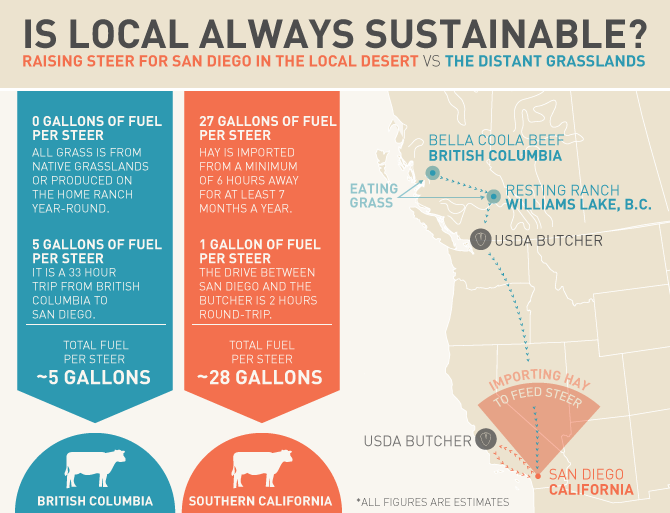
There are still the additional efficiencies of getting the beef from the USDA butcher to consumers in Southern California. This is easily solved by using Less Than Load and Back Haul trucking down Interstate 5. We maximize the capacity of commercial carriers who are heading down to Southern California anyway.
Sam Kinison seems like an unlikely expert on sustainable agriculture, but these calculations (while admittedly dry) prove his point - it simply does not make sense to try to grow certain kinds of food in the desert.
Here are some of my more detailed calculations on how much fuel would be required to raise a steer in Southern California versus raising a steer 1,800 miles away in British Columbia:
British Columbia Steer - We raise all our steers in Bella Coola, B.C. on native grasses grown on our ranch or on government grazing lands. Therefore, there is no need to truck in outside hay. We simply choose to ship the live animal to the butcher, rather than the food to the live animal.
A semi-truck uses 15.85 US gallons of fuel per hour. Our semi-driven cattle liner from Bella Coola, B.C. to our USDA butcher in Lynden, WA consumes about 277.38 US gallons, hauling 50 head or 5.54 gallons per steer- a 17-hour trip.
To reduce stress on the cattle, we also haul steers from our “resting ranch” halfway in Williams Lake, B.C. to Lynden, WA. This consumes 145.29 gallons or 2.9 gallons per steer.
Overall, our fuel usage to raise a steer amounts to about 4 to 5 gallons per steer.
San Diego Steer - The Cow/Steer Calf pair in 2012 consumes 40 lbs./day for 240 days = 9600 lbs. of hay.
The Steer by himself (after weaning) in 2013 consumes 30 lbs./day for 240 days = 7200 lbs. of hay
In total, it has taken 16,800 lbs. of hay to feed this steer to finish.
A semi-truck can carry a load of 30 tons of hay, which will only finish 3.5 steers. The closest hay fields average around 6 hours away. Many of the local horses are fed with hay that is trucked in from 6 hours away.
30 tons shipped 6 hours at 15.85 gal/hr. = 95.1 gal divided by 3.5 steers = 27.17 gal per steer. This assumes the cattle eat native grass from November to April and trucked-in hay from April to November.
The local cattle ranch that ships their cattle to Northern California found it to be cheaper than trucking in hay but they are creating an even larger carbon footprint.
Dec 28th, 2012 | By Aubrey Yee
Have a look at our most popular fuel related posts of 2012. Thanks for your support and happy holidays from Sustainable America!
Continue Reading
Dec 26th, 2012 | By Aubrey Yee
Increasing oil production in Iraq is an uphill battle with volatile economic and political realities impeding successful expansion efforts. Bernstein research breaks down some of the challenges that lie ahead.
Continue Reading
Dec 19th, 2012 | By Aubrey Yee
Wholesome Wave is a non-profit with a mission to "improve access and affordability of fresh, healthy, locally-grown produce to historically underserved communities." Its founders believe that "doing so creates economic viability through local food commerce that can rebuild our nation’s food system."
Continue Reading
Dec 17th, 2012 | By Aubrey Yee
KiOR opens the world's largest cellulosic biofuels plant with the capacity to produce up to 40,000 gallons of gasoline and diesel a day from agricultural byproducts.
Continue Reading
Dec 14th, 2012 | By Aubrey Yee
We've been taught to think of fuel efficiency in 'miles per gallon' but these researchers show that it's 'gallons per mile' that really make the difference...
Continue Reading
Dec 10th, 2012 | By Aubrey Yee
In the last decade we have witnessed an incredible amount of droughts, hurricanes, floods and now superstorms. How can we create resiliency in our food systems in the face of these increasingly frequent and extreme weather events?
Continue Reading
Dec 7th, 2012 | By Aubrey Yee
"Soladiesel" is a new 20% algae biofuel blend being offered only at Propel fueling stations for one month to see how consumers respond. Is this the wave of the biofueled future?
Continue Reading
Dec 3rd, 2012 | By Aubrey Yee
Prices for farmland across the U.S. corn belt continue to rise, attracting a new breed of investor seeking record profits.
Continue Reading
Nov 30th, 2012 | By Aubrey Yee
Kanu Hawaii's Eat Local Challenge aims to encourage production and consumption of more locally grown food.
Continue Reading
Nov 28th, 2012 | By Aubrey Yee
Check out some of the latest designs in electric sports cars to hit the road and the race track. These electric cars save on gas but they don't skimp on sex appeal.
Continue Reading
Nov 23rd, 2012 | By Aubrey Yee
The Farm Bill contains legislation relating to everything from farm subsidies, to micro-lending programs and organic growing research. Learn more about how the expiration of the 2012 Farm Bill is affecting Americans.
Continue Reading
Nov 21st, 2012 | By Aubrey Yee
With the release of the IEA's latest report, it is important to keep in mind the whole energy picture for America's future. It's clear that energy resilience will require more than just an increase in oil production...
Continue Reading
Nov 19th, 2012 | By Aubrey Yee
Qatar Airways is planning to use domestically abundant natural gas to power it's whole airline fleet as soon as late 2013.
Continue Reading
Nov 16th, 2012 | By Aubrey Yee
Studio Roosegaarde wants to create a highway that glows at night, gives you a weather report and charges your electric vehicle... and they're ready to build it as early as next year.
Continue Reading
Nov 14th, 2012 | By Aubrey Yee
Bikes Make Life Better wants to show your company how making biking easy and enjoyable for employees can make work more fun and improve health and the bottom line.
Continue Reading
Nov 12th, 2012 | By Aubrey Yee
It's important to understand that increasing domestic oil production in America will not necessarily lower prices at the pump... Instead we should focus energy on alternatives to crude oil like natural gas, advanced biofuels and electric vehicles in addition to energy efficiency measures.
Continue Reading
Nov 9th, 2012 | By Aubrey Yee
Sustainable America is focused on solutions. Although high oil prices have obvious negative effects on Americans, we are seeing a silver lining in the exciting trends in agriculture that are developing as a result of the high price of oil.
Continue Reading
Nov 7th, 2012 | By Aubrey Yee
If this innovative Swedish-American company is right, the future of farming might very well be up! Plantagon is constructing a 12-story vertical greenhouse in Sweden with plans to take their design ideas around the world.
Continue Reading
Nov 5th, 2012 | By Aubrey Yee
Not quite industrial but not fully organic, the Marsden farm study demonstrates a hybrid approach to farming that is just as productive while being better for the environment.
Continue Reading
Oct 31st, 2012 | By Aubrey Yee
Protean Electric claims to have a new system that will change how the engine in an electric vehicle works. The technology to power your car might someday be in your wheels...
Continue Reading
Oct 29th, 2012 | By Aubrey Yee
Some of the top chefs around the country are taking the concept of 'farm to table' and the local food movement to a new level by purchasing and running their own farms.
Continue Reading
Oct 24th, 2012 | By Aubrey Yee
With its high carbon emissions and the low price of natural gas, it seems that coal-fired power is on its way to being phased out.
Continue Reading
Oct 22nd, 2012 | By Aubrey Yee
The Local Food Lab, a Silicon Valley based start-up incubator, is focused on helping new social entrepreneurs get their local food business ideas up and running...
Continue Reading
Oct 19th, 2012 | By Aubrey Yee
California Senate Bill 1298 legalizes self-driving cars. And if Google owner Sergey Brin has his way, Google software will soon be driving them...
Continue Reading
Oct 17th, 2012 | By Aubrey Yee
Get started with Bokashi composting using this great infographic!
Continue Reading
Oct 15th, 2012 | By Aubrey Yee
Biofuel from wastewater? The latest innovation in the field of advanced biofuels may hold some promise for the future.
Continue Reading
Oct 10th, 2012 | By Aubrey Yee
TakeOutWithOut asks you to BYOR (Bring Your Own Reusables) the next time you get take out!
Continue Reading
Oct 8th, 2012 | By Aubrey Yee
Dirt the movie shows us how beautiful dirt is and how important healthy soil really is to our existence.
Continue Reading
Oct 5th, 2012 | By Aubrey Yee
PodPonics says that growing food in shipping containers is a 'local everywhere' approach.
Continue Reading
Sep 28th, 2012 | By Aubrey Yee
"The China Study" purports simple, straightforward advice for healthy eating - eat more plants and less animal protein. Turns out these words of wisdom are also beneficial for the environment and for reducing our energy and water use within the national food systems.
Continue Reading
Sep 26th, 2012 | By Aubrey Yee
Blue River Technology has created a weeding robot that could help to keep millions of pounds of herbicides out of the environment and out of our food.
Continue Reading
Sep 24th, 2012 | By Aubrey Yee
The milk looks fine, it smells fine, but the 'Sell-by' date passed a few days ago. Should you drink it?
Continue Reading
Sep 21st, 2012 | By Aubrey Yee
Most compost systems can't take meat and dairy. Bokashi can take it all! And with an airtight bin, it's perfect for apartments or indoor composting. No smell and no pests...
Continue Reading
Sep 12th, 2012 | By Aubrey Yee
The first commercial algae to energy facility is up and running in New Mexico, producing 'green crude' as an alternative to crude oil.
Continue Reading
Sep 10th, 2012 | By Aubrey Yee
Carbon dioxide emissions could fall by [150 million tons per year](http://files.technologist.geblogs.com/files/2011/05/Emissions-Graphic.jpg) if coal plants are replaced by natural-gas fired combined cycle plants. That's equal to taking some 13,000 cars off the road each year.
Continue Reading
Sep 7th, 2012 | By Aubrey Yee
Have you ever wondered what the food you eat has been eating during its lifetime? It's probably more complicated than you could imagine. Feed additives are huge multi-billion dollar business. From antibiotics to basic vitamins, learn more about the wild world of livestock feed.
Continue Reading
Sep 5th, 2012 | By Aubrey Yee
Peter Theil's venture capital firm Breakout Labs is betting on the future of 3-D printed meat and leather. With a grant for their research, the start-up Modern Meadow hopes to have the technology within a year that will enable meat and leather to be printed from cell cultures.
Continue Reading
Sep 4th, 2012 | By Aubrey Yee
PharmPods let you grow greens in a shipping container - almost anywhere. With a proprietary technology and a brilliant business plan, PharmPod founder Scott Dittman hopes to see greens grown all over in his innovative hydroponic growing containers. It's the type of innovation we need in the quest to develop more local food sources and reduce food miles.
Continue Reading
Aug 24th, 2012 | By Aubrey Yee
Imagine a $9 bicycle made from recycled cardboard! This is not a dream, but inventory Izhar Gafni's reality. After three years of persistent and tireless trial and error, the Israeli inventor has created a cardboard bicycle that withstands the elements, looks really cool and will help make biking financially accessible to millions more people worldwide. In the effort to reduce oil consumption, pioneers like Gafni are at the forefront of important and inspiring innovation.
Continue Reading
Aug 22nd, 2012 | By Aubrey Yee
Natural gas as an alternative to oil has been a heated topic of debate. With the release of films like "Gaslands" and other calls for alarm in the media, it's become difficult to discern reality from unfounded anxiety. We've tried to clarify this complex issue by laying out the basic arguments and evidence from both sides of the camp. With the lower emissions of natural gas and its position as a currently cheaper and domestically produced alternative to imported oil, there seems to be a strong case for natural gas as an intermediate solution to help ease America's oil addiction while we refine more long-term sustainable alternatives.
Continue Reading
Aug 15th, 2012 | By Aubrey Yee
Open Ocean Aquaculture is broadly defined as "the rearing of marine organisms in exposed areas beyond significant coastal influence." In these systems, larger pelagic fish like tuna, halibut or cod are raised for consumption.
Continue Reading
Aug 10th, 2012 | By Aubrey Yee
With the biofuels sector bringing in some $1.4 billion through investment in just 33 "biomass to energy" technology corporations, there are lots of players looking to get into the game while its still relatively early. Biomass, as a renewable energy source, is considered biological material from living or recently living organisms.
Continue Reading
Aug 8th, 2012 | By Aubrey Yee
A burger is a burger is a burger right? Well, not always so. Where and how your food was raised can make a distinct difference in the taste and nutritional quality of the food. But it’s also important to realize that the food system you choose to support every time you eat can make a difference. Large-scale industrial agriculture contributes to higher oil and fuel usage, more pesticide usage, loss of crop diversity, soil degradation and increased greenhouse gas emissions.
Continue Reading
Aug 6th, 2012 | By Aubrey Yee
At Sustainable America we found this article from Ned Davis Research important to share. As the authors John LaForge and Warren Pies illuminate, there is a perfect storm brewing in Saudi Arabia which could likely drive oil prices higher than we may have imagined in the near future.
Continue Reading
Jul 30th, 2012 | By Aubrey Yee
Just this month, a gas station in Lawrence, Kansas became the first in the nation to offer e15. E15, or Ethanol 15, is a blend of 15% ethanol and 85% gasoline. It's meant to be an alternative that would eventually replace the e10, or 10% ethanol blend, that has become ubiquitous across the United States.
Continue Reading
Jul 27th, 2012 | By Aubrey Yee
Ever wondered what it would be like to forage in your own urban environment? How hard would it be to find edible foods in your neighborhood? Urban Edibles is a Portland, Oregon based non-profit that is taking the guess work out of finding wild edible foods around the city.
Continue Reading
Jul 26th, 2012 | By Aubrey Yee
With comparisons to the dustbowl experience of the early 1930s already starting to circulate, it is still unknown how bad the drought we're experiencing this summer can get.
Continue Reading
Jul 22nd, 2012 | By Aubrey Yee
Imagine if after eating your ice cream, you could eat the package that it came in. Might sound like fantasy, but thanks to Harvard Professor David Edwards, this idea has now become reality. It's a bold and innovative move towards eliminating plastic and paper in packaging using the principles of biomimicry, a practice that looks to models, systems and elements in nature to create solutions to human problems.
Continue Reading
Jul 20th, 2012 | By Aubrey Yee
The future of biofuels remains uncertain. While many hail the advent of advanced biofuels or second-generation biofuels, the reality is that many of the newer forms of biofuel have yet to be proven viable outside of the laboratory.
Continue Reading
Jul 19th, 2012 | By Aubrey Yee
The local food movement has been gaining ground recently in the sunny city of Honolulu. At the forefront of the culinary shift are a few brave souls who believe in the power of combining locally sourced foods with creative menus and innovative restaurant concepts.
Continue Reading
Jul 18th, 2012 | By Aubrey Yee
What is a weed? According to Wikipedia, a weed is "A herbaceous plant not valued for use or beauty, growing wild and rank, and regarded as cumbering the ground or hindering the growth of superior vegetation..." A fitting description for the invasive superweeds currently inundating America's agricultural heartlands.
Continue Reading
Jul 17th, 2012 | By Aubrey Yee
The debate over GMOs (Genetically Modified Organisms) rages on with ballot initiatives this election year addressing the issue of proper labeling on food products containing GMOs, and a new batch of superweeds that are resistant to the herbicides used on GMO crops plaguing farmers across the country.
Continue Reading
Jul 16th, 2012 | By Aubrey Yee
It's not the OPEC you're thinking of. This OPEC is the Orange Peel Exploitation Company and it's composed of an international team of researchers who are looking for innovative new ways to use orange peels.
Continue Reading
Jul 11th, 2012 | By Aubrey Yee
There's a lot of talk about zero emissions from our cars, running our homes off renewable energy, even using our own bodies to create energy when we workout! But what about our flights?
Continue Reading
Jul 9th, 2012 | By Aubrey Yee
Imagine 10,000 shared bicycles distributed across 600 stations throughout New York City, all available for just 26 cents a day by purchasing an annual membership. Utilizing a private-public partnership, the city of New York has enlisted Citi Bank and Mastercard to sponsor the bike sharing program.
Continue Reading
Jul 8th, 2012 | By Aubrey Yee
Craig Venter is not your usual scientist. He's attractive and stylish, rides fast motorcycles and sails around the world. He's self diagnosed himself with ADHD, but this fact combined with his healthy ego may be the very reason he has gone so far in his field. He sets ambitious and seemingly impossible goals like mapping the human genome, which he did faster than anyone expected, and then he achieves them.
Continue Reading
Jul 7th, 2012 | By Aubrey Yee
Pineapples in Hawaii that were grown in Costa Rica, apples in New York City that came from California, the sushi on your plate in Las Vegas flown in from Japan. These days most of our food travels the world before it reaches a plate. Just like humans, who rack up a big carbon footprint when they travel anywhere, our food is racking up some mileage.
Continue Reading
Jul 6th, 2012 | By Aubrey Yee
Car sharing hits hyperdrive with an innovative new company called Getaround. Just under a year old, the company has already signed over 10,000 people up for the car sharing service.
Continue Reading
Jul 5th, 2012 | By Aubrey Yee
Information-based energy efficiency (IBEE) is the new buzz in large scale energy savings, and Opower is one of the companies leading the pack. Utilitizing the power of social media and the information gleaned from massive amounts of data, Opower is helping Americans save incredible amounts of energy (and plenty of money) each month.
Continue Reading
Jul 3rd, 2012 | By Aubrey Yee
Natural, organic, fair-trade, these are all labels on our food that we have come to trust, labels that we believe tell us our purchases are good for us, good for the environment, that the people who grew our food were treated well. But who sets the standards for the labeling and who keeps track of those standards if there are any?
Continue Reading
Jul 2nd, 2012 | By Aubrey Yee
Raj Patel is an award winning writer, activist and academic concerned with how to feed the world. He saliently points out that more than 1.5 billion people worldwide are overweight and another 1 billion are going hungry. We are producing enough calories, but not nourishing the world. There is something clearly broken about our food system.
Continue Reading
Jul 2nd, 2012 | By Aubrey Yee
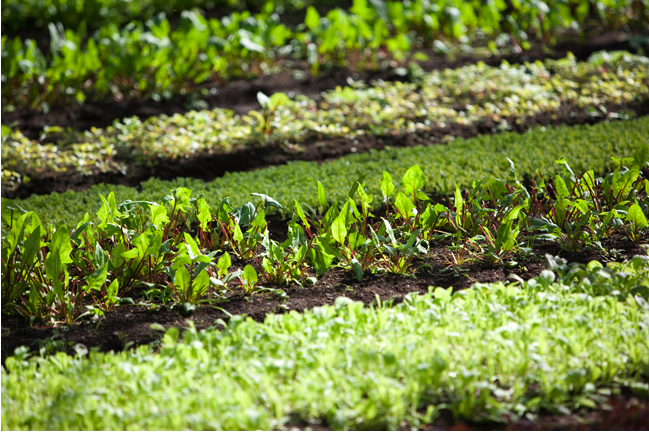 Salad greens in Stone Barns Center's 22,000-square foot, minimally-heated greenhouse. Photo: Roberto Falck Photography
Salad greens in Stone Barns Center's 22,000-square foot, minimally-heated greenhouse. Photo: Roberto Falck PhotographyThis weekend, the Wall Street Journal featured renowned chef Dan Barber and his deep and passionate commitment to the local food movement. It’s a commitment that has brought great notoriety to both his cooking and the Stone Barns Center where his unique restaurant, Blue Hill at Stone Barns, resides. The brilliant chef shares his thoughts on everything from the myth of guilt-free eating to locavorism. He’s convinced we are just seeing the beginning of locavorism’s potential. Read the article from Friday’s Wall Street Journal here.
For more on the Stone Barns Center, see our previous post, Growing a New Crop of Farmers.
Jul 2nd, 2012 | By Aubrey Yee
Badger-Bluff Fannie Freddie is America’s best Holstein bull. That’s no small feat in a field of 8 million other dairy cows. He’s so fabulous that he already has some 346 daughters on the books. This is considerable being that he was only born in 2004 and his semen was only put on the market a few years ago.
In 2009, the USDA took a look at some 50,000 markers on his DNA that were related to good milk production and officially declared him the best bull for siring milk producing daughters. They made this declaration before he had ever sired any progeny. Now that the first of his daughters have reached milk producing age, the predictions have been proven correct and the USDA’s use of big data has shown that a new sort of 21st century analysis deserves a central place in the US Dairy Industry.
While you might not expect it, dairy breeding is a perfect field for quantitative analysis of the sort that machine learning algorithms can offer today. Taking vast amounts of data and scanning for key information is what these algorithms are created to do. It’s how your Google search works and how online advertisers always seem to know exactly what you were just looking at online. In the dairy world, breeders keep copious pedigree records and sought after dairy cows need exhibit only a few important traits such as milk production, fat in the milk, protein in the milk, longevity, udder quality, all of which are easy to measure and quantify.
The reality is, in the mid-20th century dairy cows would be expected to produce less than 5,000 pounds of milk in a lifetime. Today that number is closer to 21,000 pounds. To reach these increases in output dairy producers have sometimes turned to hormones, but they have increasingly turned to genetics and careful selection of the best bred herd. The technology we have today, and the ability to screen DNA is greatly increasing the speed of a genetic selection process that has long been at work in the industry.
What this means for Badger-Bluff Fannie Freddie is a vast array of progeny scattered all over the country. He is in many ways the epitome of the modern dairy industry. An industry that is increasingly dependent upon technology and data to improve efficiency and effectively feed our growing populations.
Jun 14th, 2012 | By Aubrey Yee
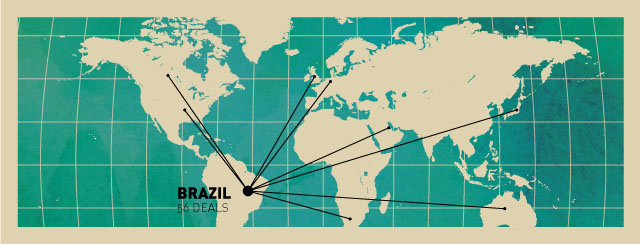
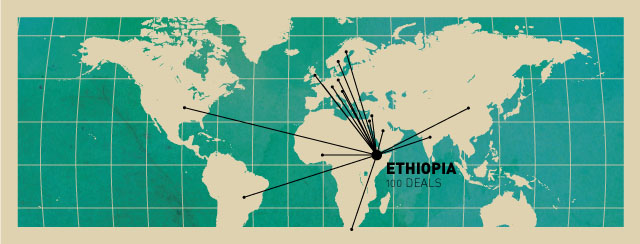
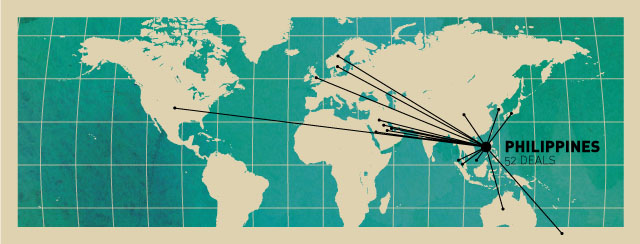
What would you do if you were the leader of a country with lots of people, little water and not enough good land for growing crops to feed your population? You might buy property in another country that can grow your food for you.
Welcome to what some are calling the “new colonialism”. It’s a great land grab sparked in part by the 2007-2008 food crisis that left some countries like China, India, South Korea and Saudi Arabia wondering how they might feed their growing populations in the future. The purchase of cheap agricultural land also promises great profit to the investors.
A think tank in California, the Oakland Institute, recently published a report titled New International Land Deals Database Reveals Rush to Buy Up Africa In the report, they explain that some 5% of Africa’s agricultural land has been bought or leased by investors since 2000. And since 2008, the pace of land deals has really ramped up without much international regulation.
In response to this alarming trend, a consortium of five major European research centers and 40 civil society/research groups has created the world’s largest public data base of international land deals. The portal was launched in April. Most of the deals have been shrouded in secrecy and a lack of available data has made it difficult to know how much land is really changing hands.
Their data has confirmed the suspicions that wealthy food-importing countries are buying up available agricultural lands in countries that already face food shortages. But increasingly, developing economies are getting in on the “new land rush”. In Brazil for example, agribusiness companies seem more inclined to invest in other South American countries while companies from South Africa tend towards investments in other less developed African nations.
But while nation-states may be leading the charge, invesment banks, hedge funds, commodity traders, pension funds, foundations and individuals are all getting involved in these land investments. Even some universities like Harvard and Vanderbilt are investing in foreign land for agriculture according to the Oakland Institute report.
The fallout of this shift in land remains to be seen, but with access to clean water a growing concern and food shortages like the famine in Somalia becoming more common, a clash between local farmers and foreign investors seems inevitable. Another report just published by the International Land Coalition and the Oakland Institute called Dealing with Disclosure aims to create greater transparency and regulation around these deals while giving local communities the tools they need to make fair and informed decisions when dealing with foreign investors.
Many of the investor countries see the purchase of viable agricultural land as crucial to their development of food security. Saudi Arabia, for example, has “earmarked $5 billion to provide loans at preferential rates to Saudi companies to invest in countries with strong agricultural potential,” according to the the U.K.-based Institute of Science in Society.
It seems that one country’s efforts to create food security may result in another country’s food shortage. To successfully feed the growing global population of 7 billion and counting, we are going to have to get creative and transparent, quickly.
Jun 10th, 2012 | By Aubrey Yee
Playing off the popularity of Al Gore’s “Inconvenient Truth” several concerned groups are now calling industrial agriculture the new ‘inconvenient truth’.
Wondering how we are going to continue to feed the 7+ billion people on this planet, a recent video by the University of Minnesota’s Institute of the Environment cites some alarming figures:
- More than 40% of the earth’s surface has been cleared for agriculture
- Global pastures cover 30 million km2–the size of the African continent
- Agriculture uses 60 times more land than urban and suburban areas combined
- Every year we use 2,800 cubic km of water on crops - its the biggest use of water on the planet, and major rivers and lakes are drying up
- Agriculture contributes more greenhouse gas emissions than all the planes, trains and automobiles on the planet combined.
http://youtu.be/hgmzV0E7ZoE
What are we to do? While there are no easy solutions, this video and others like it aim to elevate the global dialogue around this crucial issue quickly. The University of Minnesota group suggests initiatives around: incentives for farmers, precision agriculture, new crop varieties and drip irrigation. This is clearly a huge and complex issue, but one that will become increasingly present in international policy debates, and as a matter of survival, a reality we cannot ignore.
Jun 10th, 2012 | By Aubrey Yee
Replate - to place unwanted leftovers, typically in a doggie bag, on top of the nearest trash can so they don’t go to waste.
A simple concept, Replate was the brainchild of Language in Common founder Josh Kamler. The idea is designed to fight food waste by encouraging diners, particularly in urban environments, to take their leftovers to go even if they don’t intend to eat them.
Just leave the doggie bag with your extra food on top of a trash can. That way, the next homeless (or hungry!) person who comes along will be able to pick up the food and enjoy a good meal.
When you realize that some 40% of the food produced in America is not being consumed, it’s clear that we need to do all we can to curb food waste. So next time you’re out to eat, don’t leave the restaurant without your leftovers, Replate them!
Jun 8th, 2012 | By Aubrey Yee
What would our world look like without cheap and readily available oil?
If it looks anything like a Transition Town, things might not be so bad after all.
“Transition Network supports community-led responses to climate change and shrinking supplies of cheap energy, building resilience and happiness.” ~ Transition Network
The Transition Town Movement began in the towns of Kinsale, Ireland and Totnes, England in 2005 and 2006. Inspired in part by the Permaculture movement, Climate Change, and Peak Oil, Transition Towns aim to help local communities find elegant ways to transform their energy use away from oil while building local economies and all around resilience.
Rob Hopkins is typically noted as the founder of the Transition Town network, which in many ways began with his publication of a manual titled, “Energy Descent Action Plan”.
“These communities have started up projects in areas of food, transport, energy, education, housing, waste, arts, etc. as small-scale local responses to the global challenges of climate change, economic hardship and shrinking supplies of cheap energy. “ ~Transition Network
Today, you can find transition town movements springing up all over the world. Want to start one in your community? Transition Network has a wealth of information on how to successfully transition your town away from oil.
Jun 7th, 2012 | By Aubrey Yee
Exit the 405 Freeway at Euclid Ave and you’ll find the very first hydrogen fueling station that is converting sewage to fuel. This fueling station is located at the Fountain Valley sewage treatment plant, part of the Orange County Sanitation District’s wastewater treatment system.
On opening day in August of 2011, director of the program Scott Samuelson called it “a paradigm shift” explaining that “We’re taking an endless stream of human waste and transforming it to transportation fuel and electricity. This is the first time this has ever been done.” (source) The fuel comes from ‘digesters’, bacteria that break down the human waste into a biogas.
With shiny, new white and green gas pumps, the station is capable of fueling 30 cars a day currently. It also produces some 250 kw of power for use by the wastewater treatment plant. The on-site nature of the system takes any transportation logistics out of the equation making it a truly sustainable alternative.
As part of California’s goal to create a ‘hydrogen highway’ the station is part of a 3 year demonstration project. If it goes well, you can expect to see these rolled out in more locations across the state.
Jun 7th, 2012 | By Aubrey Yee
For about the last 10,000 years we’ve been living in an epoch called the Holocene. This time period has been defined by the worldwide spread of the human race and a relatively stable climate. In 2000, renowned atmospheric chemist Paul Crutzen came to believe that he was no longer living in the Holocene. That in fact mankind’s affect on planetary systems had become so pervasive and so influential that a new era had begun. He named this new era the Anthropocene and over the next few years the term began to gain acceptance in first academic and then more popular circles.
http://vimeo.com/39048998
The Anthropocene, as Crutzen and others now see it, is “the recent age of man.” A time in which all manner of ecological processes from the macro to the micro are being changed and affected in significant ways by our presence on the planet. Acknowledging that humankind’s influence is central and ubiquitous is no small shift in thinking. It is in fact a massive paradigm shift in the scientific field. A field that previously saw humans as observers of natural processes rather than creators of them.
In 2009, Crutzen along with a group of academics, published a paper titled The Anthropocene: conceptual and historical perspectives in which they contend:
The human imprint on the global environment has now become so large and active that it rivals some of the great forces of Nature in its impact on the functioning of the Earth system…In this paper, we put forward the case for formally recognizing the Anthropocene as a new epoch in Earth history, arguing that the advent of the Industrial Revolution around 1800 provides a logical start date for the new epoch.
We live in a time where geoengineering, genetically modified organisms and artificial intelligence are part of our reality and increasingly we are finding new ways to both create and affect life. Crutzen and others believe that by acknowledging the advent of a new era we force ourselves to accept our new role in managing and stewarding the processes of the natural world. Rather than seeing humans as outside observers of nature, the Anthropocene asks us to envision humans as both creators and managers of a world that we are intimately interconnected with. There is a responsibility inherent in humankind’s ability to effect biological and chemical processes all the way down to the cellular level.
In 2009 a group of international academics joined forces to create the planetary boundaries manifesto which outlines nine planetary boundaries that must be maintained for life on planet earth to sustain. Published in the journal Nature, the group calls for intervention in planetary processes where we have crossed these boundaries so as to recreate and sustain the climactic environment we have adapted to during the Holocene era. In our new role as stewards of the future, the Anthropocene era challenges us to examine much more deeply our impact on the planet and all manners of life that depend upon Earth to survive.
Jun 7th, 2012 | By Aubrey Yee
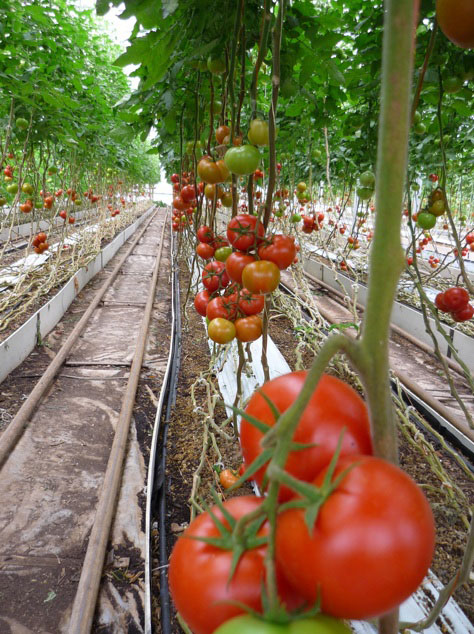 Sunizona family farms in Arizona is a veganic farm. Started in 1996 and family run, the farm produces a variety of greens, cucumbers, tomatos, herbs and a variety of seasonal vegetables, 98% of which are sold only in Arizona.
Sunizona family farms in Arizona is a veganic farm. Started in 1996 and family run, the farm produces a variety of greens, cucumbers, tomatos, herbs and a variety of seasonal vegetables, 98% of which are sold only in Arizona.
The motto behind ‘Veganic Growing’ is simply “growing without cruelty”. This form of agriculture takes any cruelty to animals completely out of the equation. What that means is that no product derived from a confined or slaughtered animal - fertilizer, manure, fish meal, etc. - is used in the growing process.
The idea is that heavy industrial livestock production has a huge impact on the environment and the animals processed live in suffering. So free range animals can be raised on a veganic farm and used to create fertilizers, but no animals will be harmed during any part of the growing process.
To substitute for the bone meal, manure, fish meal and other animal products usually used in organic and other agriculture, veganic farmers use mulch, vegetable compost, green manure, chipped branch wood, crop rotation and polyculture to create greater soil and plant productivity. Veganic farmers also reduce their use of fossil fuels because they try to obtain all the sources of fertility directly on their farm.
Veganic farming is yet another way for farmers to go beyond organic and differentiate their products from the big organic producers. Cruelty free and sustainable.
Jun 6th, 2012 | By Aubrey Yee
Whether you want to save energy because you know it’s good for the planet or because you know it’s good for your wallet, this new app for your smart phone can definitely help.
“EnergySaver allows you to analyze your current and estimate your future energy consumption instead of just analyzing or tracking past energy consumption. EnergySaver also enables you to customize and analyze each appliance’s energy consumption instead of just the overall consumption. By analyzing each appliance’s current energy consumption, you can make real changes that will translate into more money in your wallet.” (source)
The app works with iOS and Android platforms. Creators claim that it can cut your electric bill up to 10% simply by eliminating phantom loads from your household appliances. Beyond that you can begin to recognize which appliances consume the most energy and start changing your behavior to save energy and save money. The app allows multiple household profiles so you can monitor your house, your parent’s house, or should you be so blessed, your second home.
With pre-populated average rate information for all 50 states, you can compare your energy use to others in your community to see where you fall on the spectrum. The same app will also analyze your water usage and rates.
To learn more and download the app, visit Energy Saver.
Jun 4th, 2012 | By Aubrey Yee
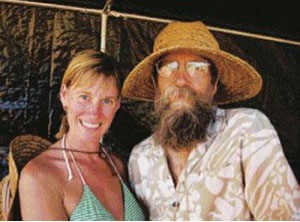 His name is Sun, and he is an organic farmer. Living off the grid, growing myriad vegetables on the island of Kauai, Sun is the living image of what you might expect of a fairytale farmer: big beard, big glasses, big straw hat. With his apprentice Lisa Fuller at his side, One Song Farm has become legendary on the island for their success at turning clay-hardened soil into gardening gold.
His name is Sun, and he is an organic farmer. Living off the grid, growing myriad vegetables on the island of Kauai, Sun is the living image of what you might expect of a fairytale farmer: big beard, big glasses, big straw hat. With his apprentice Lisa Fuller at his side, One Song Farm has become legendary on the island for their success at turning clay-hardened soil into gardening gold.
Once a carpenter managing big jobs in Southern California, Sun moved to Kauai several decades ago and leased some land to begin farming. Rather than just planting seeds, he began tending the soil itself. He started using a technique he calls “double digging” in which the tough soil in each vegetable bed is hand dug down to two feet and then worked with lots of rich organic compost and worms. It’s an admittedly intensive process but one of the secrets to Sun’s long term success. And as he explains, “After about five years it’s a piece of cake. There’s no more tilling (the soil), you just throw seeds at it.”
When Sun first moved to Kauai, he was told that organic farming would never work on the island where large plantation style agriculture had always ruled. Undaunted, Sun charged ahead, his credo “The difficult we do right away, the impossible takes a little bit longer. Once you give the plants what they need, like the right variety, in the right soil, you are going to have produce that you simply can’t believe is so-o-oo good.”
In keeping with Sun’s strong ethic of maintaining a low carbon footprint, the produce grown on One Song Farm can only be found at locally owned grocery stores and farmers markets on the island of Kauai. Recently, One Song Farm hosted a dinner at the farm with foods grown on the farm in concert with local Kauai sommelier and farm-to-table advocate Colin Darrell. Darrell is founder of the Grow Culture initiative, a Hawaii state wide virtual farmers market that aims to connect farmers and consumers in innovative ways online.
To further his organic cause in the islands Sun, along with another local organic farmer Phil Sheldon, created HOFA - Hawaiian Organic Farmer’s Association - which certifies organic farming under the USDA’s National Organic Program Federal Organic Rule.
Clearly living his own labor of love, Sun has built an organic legacy on a beautiful, remote tropical island, which is definitely worthy of storybook status.
Jun 1st, 2012 | By Aubrey Yee
When you think of ‘energy’, ‘snail’ is not usually the next word that comes to mind. But researchers at Clarkson University aim to change that. They have implanted a living snail with a biofuel cell that creates electricity using the snail’s natural glucose as fuel. Really, we’re not making this up!
The snail lives its life as usual with some electrodes implanted in its body and then connected to an external circuit. PETA may not love the technology, but the scientists involved in the study maintain that the snails live a happy and mostly uninterrupted life.
While the technology is admittedly in its infancy, the eventual idea is to create robotic life that can internally power itself. It’s no
surprise that the Department of Defense is very interested in the research. They have been looking for ways to increasingly remove live humans from battle and replace them with different types of robots.
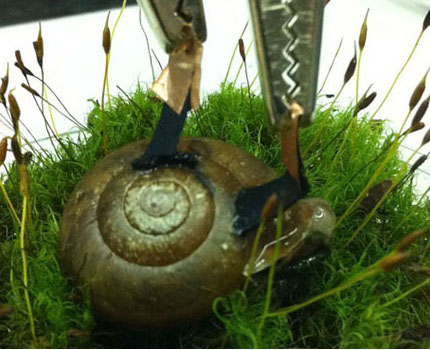 This research, published in the Journal of the American Chemical Society, is not the only paper dealing with electricity produced by living creatures. A similar study was just conducted by Daniel Scherson at Case Western Reserve University in Cleveland, Ohio. In his study, the creature of choice was a cockroach. Just imagine, your house could someday be powered by a hoard of wild cockroaches. Ew!
This research, published in the Journal of the American Chemical Society, is not the only paper dealing with electricity produced by living creatures. A similar study was just conducted by Daniel Scherson at Case Western Reserve University in Cleveland, Ohio. In his study, the creature of choice was a cockroach. Just imagine, your house could someday be powered by a hoard of wild cockroaches. Ew!
Photos: Clarkson University
Jun 1st, 2012 | By Aubrey Yee
Food Desert Locator from the USDA
## What is a food desert?
It’s an area where healthy, fresh food is difficult to obtain. There are increasing areas of America today where the only convenient place to buy food is a convenience store….which means a dearth of healthy, fresh whole foods for many Americans. In these food deserts, the supermarkets and the fresh food have simply moved out of town.
The USDA created this Food Desert interactive map. You can click on any shaded area to find out the population there without access to fresh foods as well as interesting and useful facts like the number of people in that area who are low-income or children ages 0-17.
Where the easiest thing to buy is chips, soda or a fast food burger one would think that rates of obesity and other diet related health issues are rising. But in fact, recent studies cited in articles by Mother Jones, the New York Times, and the Atlantic magazine have shown that income rather than access to fresh and healthy foods plays a greater role in obesity rates. What does that mean for policy makers and non-profits trying to tackle the obesity problem? Perhaps access isn’t the only issue…
- Access: healthier foods are less available
- Cost: healthier foods cost more
- Skills: healthier foods require preparation and cooking
- Equipment: cooking healthier foods requires kitchen facilities, pots, and pans
- Transportation: even if stores are available, they might be too far away
- Quality: even if stores sell fruits and vegetables, they might not be fresh
- Marketing: fast foods, snacks, and sodas are heavily marketed in low-income areas
(from The Atlantic)
Of these, it seems that cost might be the number one stumbling block on the path to healthier eating. When given the choice between fresh vegetables to cook into a stew or a drive through $1 fast food menu, you can imagine the more common choice for a cash-strapped, time-strapped, recession riddled, working family of four. It seems we’re going to have to find ways to make fresh healthy foods not only more accessible, but also more convenient and inexpensive like their Mc-counterparts.
May 31st, 2012 | By Aubrey Yee
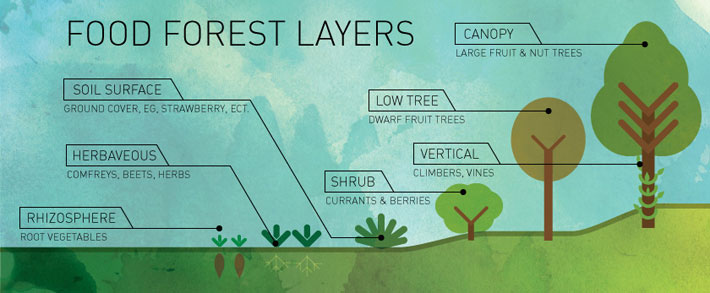
What is a food forest?
The first of its kind in the US, the Beacon Hill Food Forest in Seattle “is a gardening technique or land management system that mimics a woodland ecosystem but substitutes in edible trees, shrubs, perennials and annuals. Fruit and nut trees are the upper level, while below are berry shrubs, edible perennials and annuals.”
This is nothing short of revolutionary. Imagine if all the public spaces in our cities were full of edible foods free for the taking? The seed for the idea started in a permaculture design class. Then, momentum for the idea grew and a community group was started called Friends of the Food Forest.
It wasn’t easy to get the local community to agree to converting the seven acre public park into a self-sustaining food source. The natural objections ranged from “what happens if someone gets hurt picking fruit?” to “what if one person eats all the bluberries?”
To garner widespread support, the visionaries behind this project engaged in public outreach including mailing thousands of informational postcards, hosting informal events and soliciting input from all the members of the surrounding communities.
For the planners of this food forest, a picked over blueberry bush is not a problem, in fact that would be seen as a true measure of the park’s success.
The food forest is currently in the initial stages of development. The plan calls for a 1.75 acre test zone to be completed this year with a $100,000 grant. If the test is successful, the remaining seven acres will be developed in a few years. It’s a model for other cities to follow, and definitely one to watch.
May 31st, 2012 | By Aubrey Yee
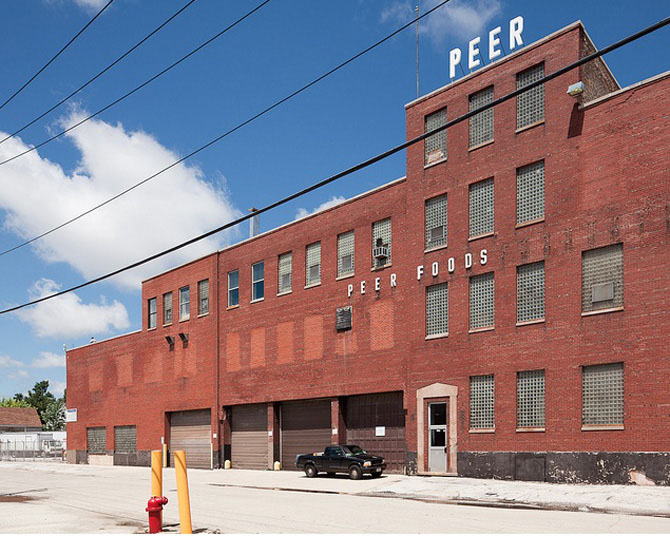
Imagine that decrepit old building you drive by every day on your way to work, the one with the cracked windows and cobwebs visible in the morning light, transforming into a vertical farm that produced tons of delicious fresh food and literally zero waste. Sound like a dream? Well in Chicago’s meatpacking district this vision has become reality. There you can find “The Plant”, a 93,500 square foot old meatpacking plant that entrepreneur John Edel has transformed into a co-op vertical farm and food business incubator.
Because of its history in meatpacking, the building already contained food-grade materials which allow for legal and safe food preparation (no asbestos here!) With an eye towards bringing manufacturing jobs back into the city, Edel decided to stick entirely with food in his building.
Inside “The Plant”, a name with now double meaning, there are a few bakeries, a kombucha tea brewery, tilapia fish farm, mushroom garden, and three aquaponics farms. Now they want to add a brewery so that the grain waste from brewing beer will be able to feed the fish farm, and the waste from the fish will feed the mushroom farm and the plants will clean the water and send it back to water the fish. No waste, everything is used…
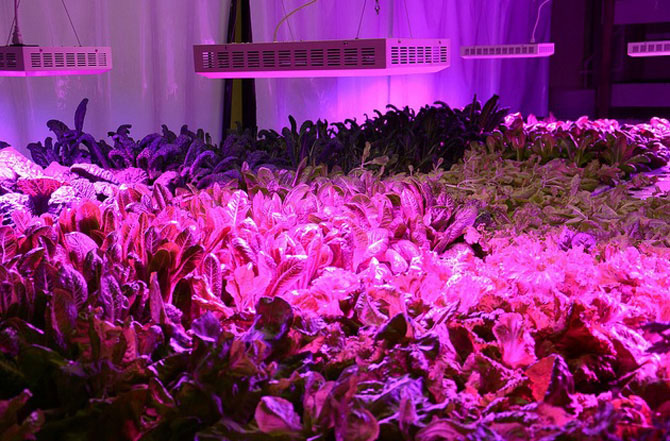
If you’re in Chicago, you can tour The Plant to see how things run or even give a few hours as a volunteer to learn some new skills. And if you’re really ambitious, find out a way to convert your local urban eye sore into a wonder house of food production for your community.
May 29th, 2012 | By Aubrey Yee
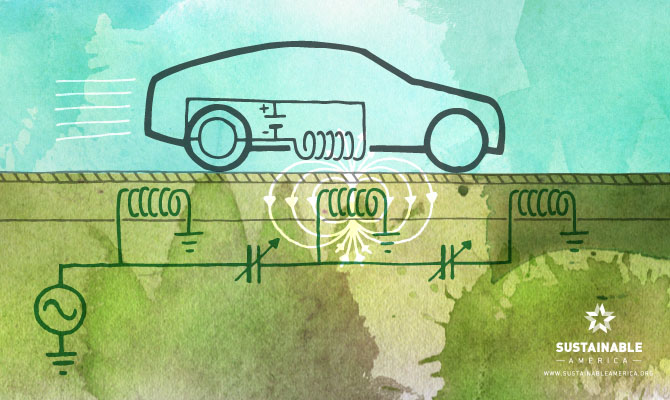
You just got a shiny new electric vehicle, you’re hip and ready to go. Driving could be a dream, but where are you going to “fill up”?
What if you could charge your new car while driving it? Sounds fantastical, but actually the ability to charge while you drive with wireless technology may be just around the corner.
Researchers at Stanford have come up with a wireless charging technology that uses “magnetic resonance coupling” - in other words, copper coils in your car and in the ground transfer electricity between each other while you are driving. Charge while you’re driving and you never have to stop to refill your battery!
This potentially revolutionary new system is outlined in a paper recently published in the journal Applied Physics Letters.
While there are some kinks to be worked out, the idea behind the technology is quite innovative and tackles head on the “range anxiety” that many people feel when deciding whether or not to purchase an electric vehicle.
Imagine a carpool lane magnetized for electric cars only. It would require tearing up some of the freeway pavement, but the metal coils needed to make it run are very affordable. One more important innovation on the road to a new way of driving.
May 28th, 2012 | By Aubrey Yee
Nestled in the redwoods of northern California’s Mendocino county is the small town of Willits. This community is the home of the farming pioneers Ecology Action, and the home of their Grow Biointensive mini-farm.
Founded in 1971, Ecology Action was first headquartered in Palo Alto, CA. The project’s original aim was and still is to “teach regular classes, collect data, make land available for gardening and publish information” on the techniques of Biointensive agriculture. The work grew from a collective concern about worldwide starvation and malnutrition as a result of overpopulation.
At the foundation of the Grow Biointensive method are the scientific principles which underlie ancient traditional farming methods such as:
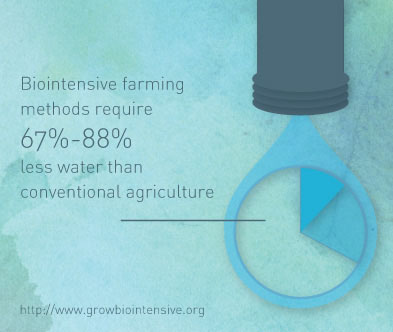 The methods aim to minimize water inputs (done properly this method requires 67-88% less water than conventional agriculture) and produce more food on less land by increasing the soil health and producing food without the use of petroleum or natural gas products.
The methods aim to minimize water inputs (done properly this method requires 67-88% less water than conventional agriculture) and produce more food on less land by increasing the soil health and producing food without the use of petroleum or natural gas products.
According to Ecology Action, “There may be as little as 40 years of farmable soil remaining globally. For every pound of food eaten, 6 to 24 pounds of soil are lost due to water and wind erosion, as the result of agricultural practices.” This means that soil health should be a top priority for anyone passionate about food security for the future.
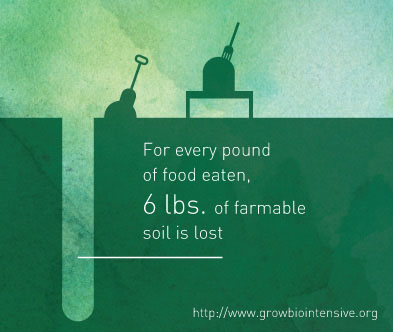 The group now holds workshops at the farm in Willits and at other locations around the country teaching others how to grow more food with less space, save water and replenish soil during the process.
The group now holds workshops at the farm in Willits and at other locations around the country teaching others how to grow more food with less space, save water and replenish soil during the process.
May 27th, 2012 | By Aubrey Yee
What is Vermicomposting?

It almost sounds like a foreign word, but vermicomposting is the process of using worms to compost food waste into a rich, black humus. The “humus” is actually a compost of the worm castings (castings is a fancy way of saying: worm poop!)
The worms eat the food scraps, paper, etc that you put into your bin and their excrement is a rich, black, dirt-like compost that your plants will absolutely love! (and it has no smell, it really looks and feels like dirt, so don’t worry!)
To get started you need:
If you choose to buy a worm bin, there are a few different styles to choose from.
There are also several websites that will help you build your own worm bin.
Once you have the bin and the worms, you’ll want to prep it for success. The worms like paper including your junk mail minus the plastic parts. They eat most food waste as well with the exception of dairy, meats and citrus (although citrus is ok in small amounts).
The first time you put the worms in the bin make sure you have a good mix of paper and food waste. The shredded up paper/newspaper/old magazines/cardboard is called “bedding” and you’ll need a good layer of bedding to start your bin off. Make sure you shred it well so the worms can move around and through the bedding. Spray a little water on the bedding to get it damp.
You’ll want to add some of these paper products every so often so the inside of the bin doesn’t get too wet. The heat inside the bin creates water vapor and your worms can drown in too much water!
Most bins will have a valve to drain excess water. The water is actually called “worm tea”. This brown “tea” is also great for your plants or your garden.
Expect to harvest your worm castings every few months. All you need to do is keep feeding your worms. The amount of worms you’ll need depends on how much kitchen waste you produce each day. Start with one pound of worms for a typical family of four and add more if they aren’t eating the food fast enough.
It helps to chop or cut up the food and paper waste before putting it in your bin. The worms will be able to eat it faster.
The worms will keep reproducing and if a couple escape into your soil it’s good for the whole ecosystem so don’t worry! The great thing about worm bins is they don’t smell - as long as you follow the rules and don’t put in any dairy or meat. It’s a great way to up-cycle almost all your food waste. And when you put the compost back into your garden to grow more food, you’ve created a closed-loop, truly sustainable food system.
May 26th, 2012 | By Aubrey Yee
What is food waste and what can I do about it?
Food waste is a significant problem. According to the United Nations Food and Agriculture Organization, approximately 1/3 of food produced for humans in the world is either lost or wasted.
Think about that for a moment: 1/3 of the food we produce and all the energy, time, resources (water, land) and money that went into growing it, packaging it and shipping it is wasted.
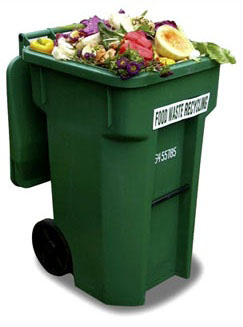
Here are a few other startling facts from the UNFAO website:
Some of this loss is due to poor infrastructure, especially in developing countries, when the food is processed, stored and package for distribution. But a lot of the waste comes from consumers in the developed world.
What can you do to curb your own food waste?
It’s time to realize that throwing away food is no longer acceptable practice. Raising awareness and changing personal habits is the first step.
May 26th, 2012 | By Aubrey Yee

Electric scooters are all the rage in some cities. San Francisco is launching Scoot Networks, a scooter version of the Zipcar idea, next month. Subscribers pay a monthly fee to access a city-wide network of super cute electric scooters.
 You can find the scooters nearest you with your smartphone. Your phone then slips into a dock on the scooter’s dashboard to unlock it and voila! you’re off and riding.
You can find the scooters nearest you with your smartphone. Your phone then slips into a dock on the scooter’s dashboard to unlock it and voila! you’re off and riding.
The scooters top off at about 30 mph and go for about 30 miles before they need a charge, perfect for the range of city riding. Scoot Networks was one of the companies chosen by the Greenstart cleantech startup accelerator program which provides start up capital to innovative cleantech business ideas.
Photos Wired.com
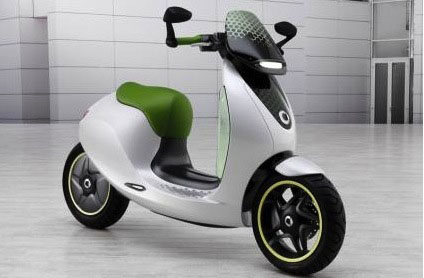
In other great scooter innovations, the people of smart, an eco-subsidiary of Daimler, are now developing a scooter line called eScooter. It’s cute and fast, up to 30 mph with a 60 mile range on full charge. Originally unveiled during the 2010 Paris Motor Show, the scooter is just one part of Daimler’s overall strategy to create comprehensive urban mobility for the future. Photo Daimler
May 24th, 2012 | By Aubrey Yee
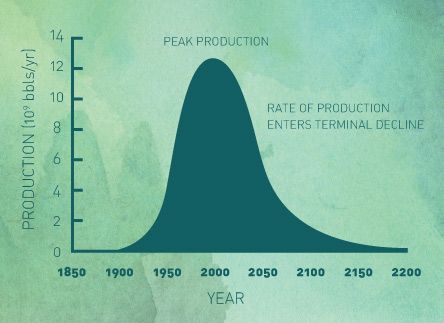 What is Peak Oil?
What is Peak Oil?
Peak oil is not the end of oil. It’s not as if all the reserves in the world are just going to dry up. Rather, it’s the end of cheap and available oil, something we humans have become quite used to in the last 100 or so years.
EROEI is a term often tossed around in this field of study. It stands for Energy Return on Energy Investment. What this measures is how much energy you create or extract minus the energy you spent during the process. For example, when oil was really cheap and more easily available in 1930, the EROEI was about 100:1. In 2004, when extraction had become much more difficult and costly, it was approximately 11-18:1. That is a significant difference.
When the EROEI is less than 1:1 that energy source becomes what is called an “energy sink” and is no longer feasible from a practical economic perspective. You can’t use more energy to extract the energy that you plan to use, it’s simple math. Peak oil means that the cost to extract oil from the ground will create such low EROEI that oil will no longer make sense as a primary energy source.
This is concerning for many reasons:
It is possible for America to get on a speedy path to sustainability, but it will take a serious and concerted dedication of resources and innovation to achieve real energy and food security. Ready… set… go!
May 24th, 2012 | By Aubrey Yee
I imagine some day hundreds of years from now, when a future humanoid describes the fossil fuel era, they may say something like this:
Humans found the decomposed bodies of long dead organisms big and small buried under the ground. They created a way to burn this sludge and create energy that they used to power all kinds of machines. Unfortunately, the burning of this sludge created all kinds of other problems in the air, water, soil and in the bodies of living beings. Then, the humans realized that there were only so many organisms buried under the ground and they couldn’t keep burning them forever.
http://youtu.be/cJ-J91SwP8w
The term fossil fuels refers to the fuel sources coal, petroleum and natural gas which are all made from the decomposed bodies of once living organisms. It takes millions of years for the bodies of these once living creatures to become the fossil fuels that we use for creating energy today.
We live in a peculiar time. With fossil fuels discovered just a few hundred years ago, we have been depleting a resource that took millions of years to create at a pace that is clearly unsustainable into the future. Yet, until quite recently humankind has not been compelled to change in any significant way. The result is a global economic system that is intimately and perilously dependent on these buried dead organisms.
While there are debates about the reality of Peak Oil, it is clear that we will need to get creative about alternative forms of energy, quickly.
The rising price of oil is unsustainable for America’s economy. In addition, our leaders have acknowledged that our dependency on imported fossil fuels has become a matter of national security. It is clear that alternative renewable energy sources and energy efficiency will be key to creating a sustainable future for America and for the world.
May 23rd, 2012 | By Aubrey Yee
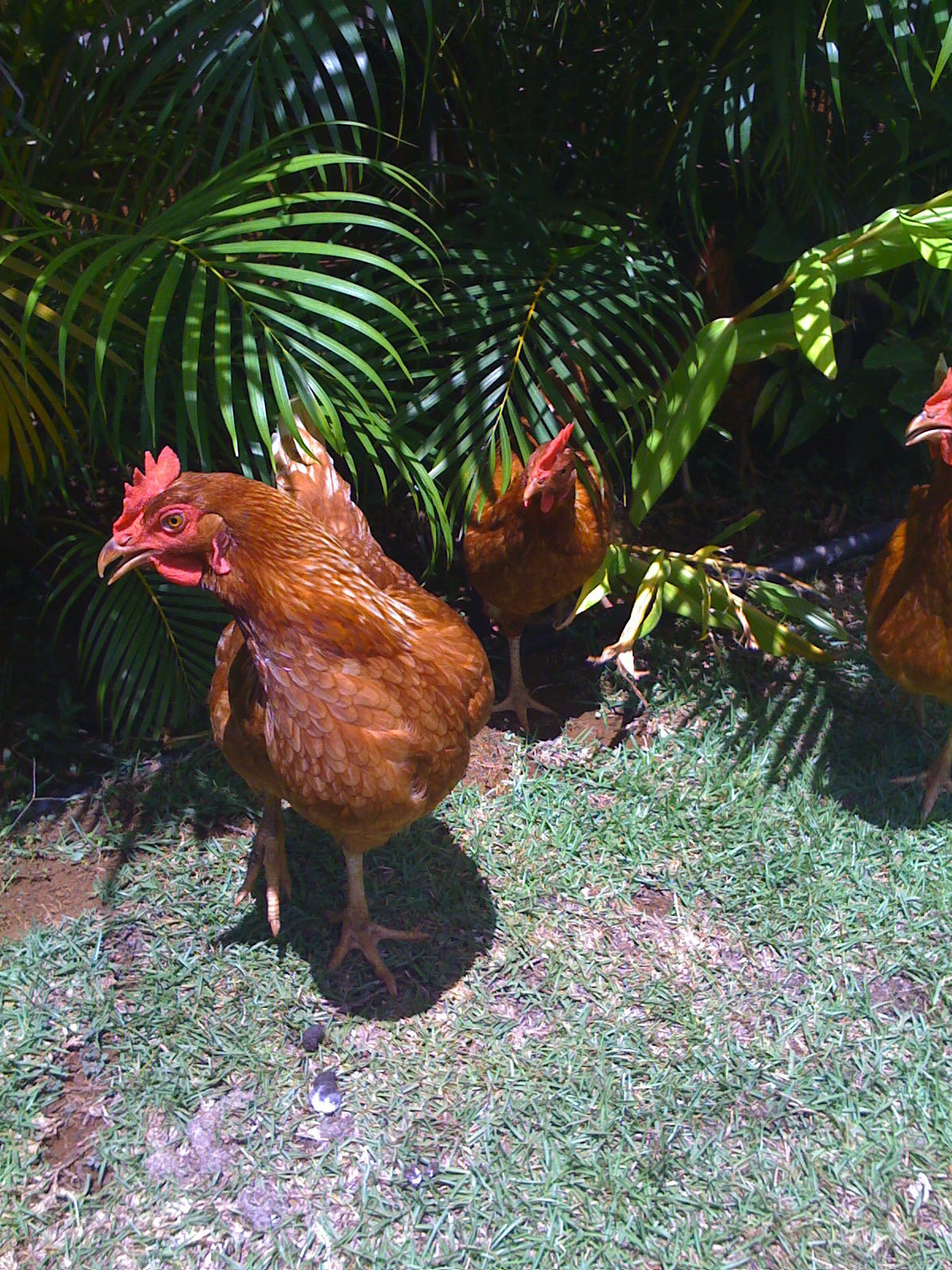 Imagine having access to your own eggs, fresh, every day. When you have your own backyard chickens, you will have access to all the eggs you can eat and you will know exactly what your chickens ate to make those eggs. Chickens are also great upcyclers, they will eat almost all your kitchen scraps - vegetables, fruit, bread, rice… basically anything but chicken!
Imagine having access to your own eggs, fresh, every day. When you have your own backyard chickens, you will have access to all the eggs you can eat and you will know exactly what your chickens ate to make those eggs. Chickens are also great upcyclers, they will eat almost all your kitchen scraps - vegetables, fruit, bread, rice… basically anything but chicken!
Many counties have restrictions on livestock, so check to make sure that backyard chickens are legal in your neighborhood before you start. Courtesy to neighbors is also important protocol. Chickens are noisy animals so you want to bu sure that you place your coop out of neighbors ear shot.
When building a coop, a place for the chickens to nest and sleep at night is crucial, and you should plan for a larger enclosure where they can roam and eat bugs and the feed that you give them.
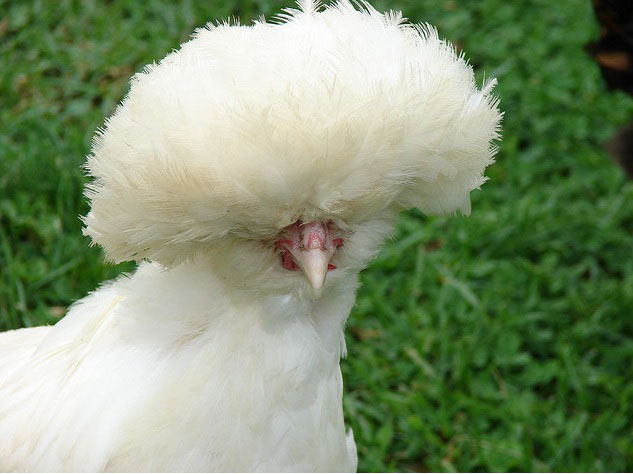
If you want to start with baby chicks, you can buy them online. There are lots of websites that sell different breeds of chicken. If you want a real egg laying machine, check out the Rhode Island Red, but there are also more exotic breeds like the Poodle Chicken… enough said.
If you start with chicks, you’ll want to keep them in a box with a warming lamp for about the first 6 weeks and they will only eat chick started feed until they get old enough to be on their own in the coop.
For the coop and enclosure, make sure you have:
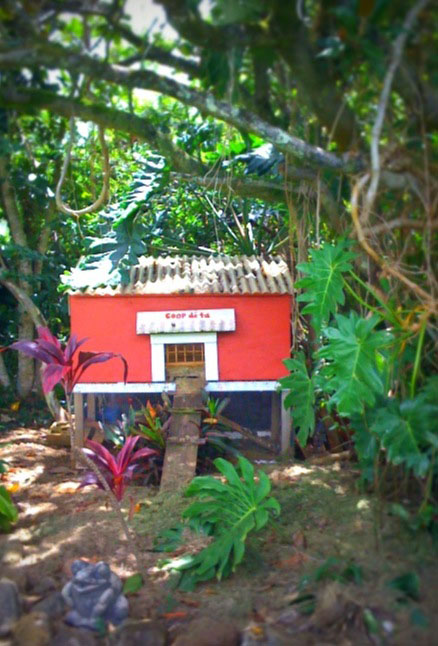 If you have a fully secure enclosure then you don’t have to clip their wings. If your enclosure is just fenced, you will have to clip the chickens wings every few weeks. They are birds and they can fly!
If you have a fully secure enclosure then you don’t have to clip their wings. If your enclosure is just fenced, you will have to clip the chickens wings every few weeks. They are birds and they can fly!
For some great coop designs and more information on caring for your chickens, check out Backyardchickens.com and don’t forget to ask your friends for creative omelet recipes!
<br style=’clear:both;”><br style=’clear:both;”>
May 22nd, 2012 | By Aubrey Yee
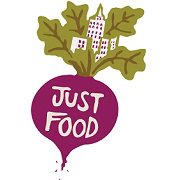 In New York City, a innovative new program aims to bring healthy, fresh food to food pantries and the citizens they serve. Just Food is a New York City non-profit that “connects communities and local farms with the resources and support they need to make fresh, locally grown food accessible to all New Yorkers.”
In New York City, a innovative new program aims to bring healthy, fresh food to food pantries and the citizens they serve. Just Food is a New York City non-profit that “connects communities and local farms with the resources and support they need to make fresh, locally grown food accessible to all New Yorkers.”
Through Local Produce Link, some 44 farmers are connected with New York’s Food Pantries to provide fresh produce. Each food pantry receives approximately 200 lbs. of mixed vegetables each week, about 6 to 10 boxes. The produce varies with the season and often includes more unusual vegetables like bok choi (an asian cabbage) that patrons of the food pantry can try.
Farmers are paid by the pound through funding from the New York State Department of Health’s Hunger Prevention and Nutrition Assistance Program (HPNAP).
Just Food also hosts community cooking programs and provides resources for recipes and nutrition information to help food pantry clients learn how to prepare the vegetables they receive in healthy ways. They host Farm Visits so that food pantry volunteers and clients can meet the farmers that grew their food, making the connection from farm to table.
May 21st, 2012 | By Aubrey Yee
Once upon a time food was eaten in season and in place. That meant no strawberries in winter, no pineapples either. It also meant you’d be hard pressed to find sushi in Las Vegas. Cheap and abundant oil changed all that. And surprisingly not very long ago.
It was really the advent of the modern American interstate roadways in the 1950’s pioneered by Eisenhower that created a way for farmers to cheaply and quickly get their food from farms to tables far away. Today, food is often shipped thousands of miles, or in the case of the sushi in Las Vegas, flown to far flung destinations in refrigerated cargo containers.
Upon signing the “National System of Interstate and Defense Highways” Act into law, Eisenhower is quoted as saying, “More than any single action by government… this one would change the face of America… Its impact on the American economy – the jobs it would produce in manufacturing and construction, the rural areas it would open up – was beyond calculation.”
The new roadways combined with cheap and abundant oil to power trucks for shipping have completely changed the way American’s eat. We think nothing of seeing strawberries in the grocery store on a cold winter morning and nothing of the ability to order New Zealand Lamb on a menu. These are luxuries we have come to expect. But many who subscribe to the locavore movement say that to have a truly Sustainable America, we need to get used to eating food grown closer to home.
Locally grown whole foods are more affordable, support local businesses, have lower carbon footprints as a result of less transportation and are all around healthier than mass produced, processed foods. That means eating in season and eating according to place.
May 17th, 2012 | By Aubrey Yee
8 Extraordinary Greens is a visionary project by artist Jenna Spevack. By constructing 8 pieces of furniture - a chair, kitchen cabinet and suitcase among others - she aims to encourage ideas about how to use our most domestic of objects in new ways to grow food. What could be more local than a dining chair that doubles as a salad garden?
Jenna’s aim is to: provide healthy greens to extraordinary people with ordinary incomes. To do this, she developed a sub-irrigated system for growing micro-greens - energy packed, edible plants, that uses lights and stainless steel growing trays incorporated into the furniture.
On the one hand an architectural design project, this is on the other hand an abstracted artist comment on the different values we place on food. In one exhibit, she explores Aesop’s fable “The Cock and the Jewel” which is a tale with lessons on relative value.
At her “farmstand” exhibit, visitors have the option to purchase 8 different micro-greens. You determine the price of your own exchange based on a set of choices that will support local, urban agriculture non-profits in New York city. Each transaction is recorded in the form of a “receipt” signed by both the visitor and the artist. A duplicate “receipt” is created and hung in the gallery to show the collective nature of all the different choices and donations made.
The project is on display now through June 2nd at the Mixed Greens Gallery in NYC.
May 6th, 2012 | By Aubrey Yee
Thousands more farmer’s markets are getting ready to accept food stamps as a form of payment. As part of the USDA’s (US Department of Agriculture) mission to get Americans eating more healthy, fresh food, they have been working to encourage the use of EBT (Electronic Benefit Transfer - another term for “food stamps”) at the markets.
Today less than 25% of the nation’s 7,000 registered farmers markets accept EBT as payment. But a recent report from the USDA shows that spending at the farmer’s markets under the Supplemental Nutrition Assistance Program (SNAP) has jumped 400%. With more markets coming online to accept EBT, those spending figures are expected to increase. The trend is great for farmers and for those who have traditionally been unable to afford to buy local produce at the markets.
In May of this year, the USDA announced plans to begin allocating funds to the states that have the highest number of farmer’s markets without the ability to access EBT. The funds will be used to help those markets purchase the wireless point-of-sale technology that is needed to run the EBT cards as a form of payment. The $4 million fund aims to bring some 4,000 more markets online. California is the recipient of one of the largest grants of $426,945 to service 687 markets (Associated Press).
The USDA website has a search function to find the farmers market nearest you. And you can narrow the search down to which markets accept subsidized payments. With its innovative approach the USDA has made supporting local farmers and eating healthy, locally grown food just a little bit easier.
Apr 20th, 2012 | By Aubrey Yee

eat less. give more. go halfsies. - it’s a straightforward slogan with a grand mission.
Halfsies is a “social initiative offering a choice to restaurant-goers that provides a healthier meal portion, reduces food waste and supports the fight against hunger.”
Their informational booklet explains how American’s portion sizes have grown over the years leading to an over consumption of daily calories and a nationwide obesity epidemic.
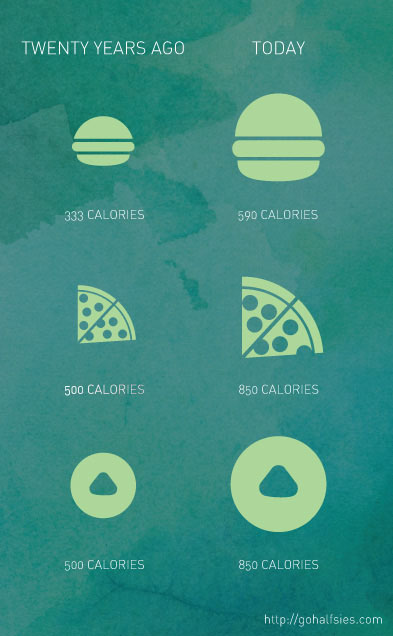
They also explain that some 40% of our food in America is wasted; it is not consumed. That means that every day Americans waste enough food to fill the Rose Bowl Stadium.
If only 5% of our food scraps were recovered, it would be enough to feed 4 million people for a day according to the FDA.
By offering a half-size portion option in participating restaurants, Halfsies aims to educate the public about these issues while tackling the problem of food waste head on and getting donations to the non-profits who are addressing world hunger.
Apr 8th, 2012 | By Aubrey Yee
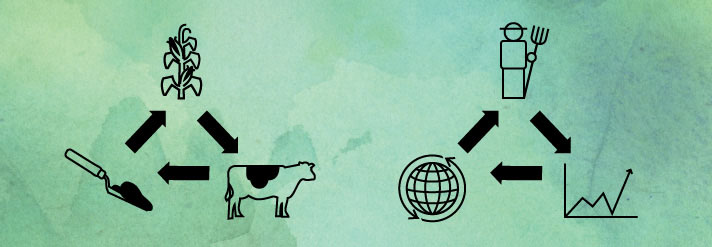
What is biodynamic farming?
There’s organic, and then there’s biodynamic. Taking organic farming a few steps further, biodynamic farming incorporates social, ecological and economic sustainability into consideration for the total health of the soil as well as the plants and animals that are cultivated on it.
Based on the teachings of Dr. Rudolph Steiner, who also founded the Waldorf school movement, the foundation of biodynamic agriculture is in Steiner’s philosophical ideals which he labeled “anthroposophy”. In this system, nature is seen as an interconnected whole organism with its own rhythm to be observed, respected and supported.
From the Biodynamic Farming Association: “Biodynamics is thus not just a holistic agricultural system but also a potent movement for new thinking and practices in all aspects of life connected to food and agriculture.”
Following phases of the moon, consideration of soil microorganism health and using precise mixtures of minerals and biological composts to replenish the system, biodynamic farming aims to create an ecosystem that needs little to no imports to maintain its health and produce delicious food.
By supporting the total “immune system” of a piece of land rather than just the particular symptoms of a crop, like pests or low yields, biodynamic farming seeks to build a robust and healthy complex and adaptive environment.
The Demeter Association founded in 1985 has taken on the lofty mission of “healing the planet through agriculture.” They describe the biodynamic style of agriculture as a perfect example of a truly sustainable closed-loop system, “It is the biodiversity of the farm, organized so that the waste of one part of the farm becomes the energy for another, that results in an increase in the farm’s capacity for self-renewal and ultimately makes the farm sustainable.”
Biodynamic farms and vineyards can now be found all over the country and internationally. For those interested in learning more, check out these online resources or attend a Biodynamic farming conference this November in Madison, Wisconsin.
Apr 3rd, 2012 | By Aubrey Yee
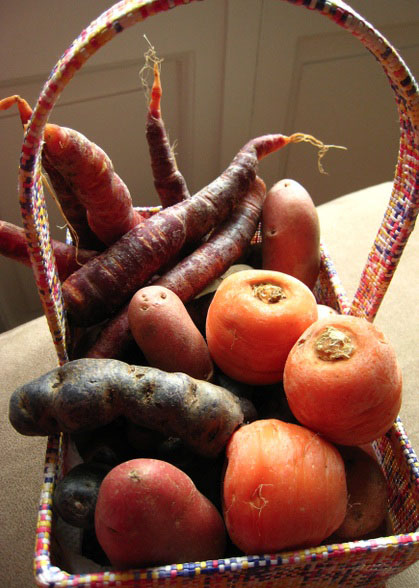 Once upon a time carrots were purple. Really they were! In Roman times, almost all carrots were purple or white. It was a mutant variety that had the orange color and sweeter taste. It took some industrious Dutch farmers several generations of breeding to select out the orange carrot that we have come to expect today.
Once upon a time carrots were purple. Really they were! In Roman times, almost all carrots were purple or white. It was a mutant variety that had the orange color and sweeter taste. It took some industrious Dutch farmers several generations of breeding to select out the orange carrot that we have come to expect today.
Most modern plants and livestock varieties share a similar history of selective breeding. While we only see two or three types of potatoes in a typical American grocery store, in the South American Andes there are some 5,000 potato varieties grown.
“Heirloom” or “heritage” plants and livestock breeds are important to maintaining food resilience. In the world of livestock, heritage animals were bred over time to produce more milk, gain weight quickly, and withstand the conditions of typical industrial production such as more cramped quarters and confinement. The heritage breeds on the other hand are often more capable of withstanding diseases and environmental changes, qualities that may be important in the future.
The American Livestock Breeds Conservancy is one of the non-profits focused on conserving the genetic heritage of over 180 breeds of livestock and poultry.
The Seed Savers Exchange is a non-profit that saves and distributes heirloom plant varieties. They believe, “A vibrant, diverse plant world is necessary for our survival, but that world is increasingly threatened by climate change, habitat loss, and over-exploitation.” The Millennium Seed Bank Partnership estimates that some 60,000 to 100,000 plant varieties are currently under threat of extinction.
In an effort to shift the tide and preserve the genetic diversity of plants in cultivation, the Seed Savers have a library of resources and an online store and catalog where you can purchase heirloom seeds for your garden. Try out some white cucumbers or delicious heirloom tomato varieties to do your part in propagating rare seeds and sowing sustainability.
